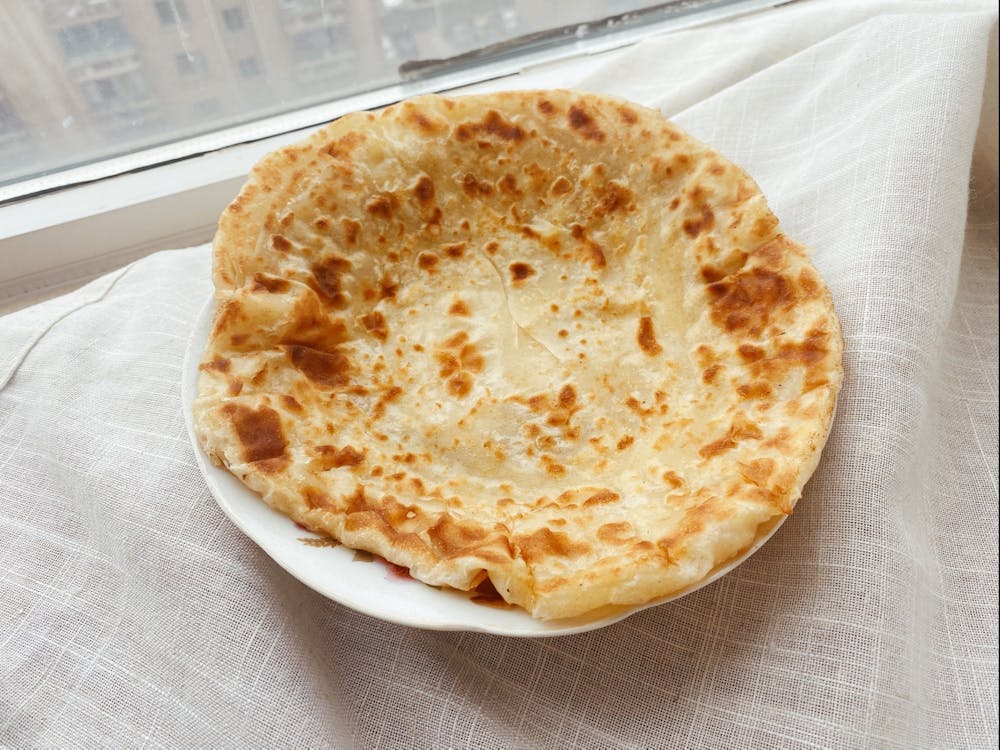It has been a year since the beginning of COVID-19 and quarantine. Due to the pandemic, a lot of restaurants were closed in my hometown — one of them was a small pancake restaurant called Aunt Wang’s Breakfast Shop (王大妈早餐铺), which I visited every morning on the way to primary school. It was an important part of my childhood, and I feel nostalgic whenever I think about how their pancakes tasted.
There were various breakfast diners next to my primary school. The cooks were always busy making Chinese hamburgers known as rougamo (肉夹馍), deep-fried doughnut sticks (油条)and classic Chinese tofu drinks (豆腐脑). Despite being busy preparing all this food, the cooks would never forget to say “Enjoy!” or “Have a nice day!” Even though it was hard to choose what to buy from the diners, a pancake and a bowl of soybean milk was my favorite breakfast pairing, and I never got tired of it throughout my six years of primary school. They always gave me energy and made going to school much more enjoyable.
Fast forward to 2021, where quarantine has given me plenty of time to try out recipes. Naturally, I decided to experiment with the pancake to see if I could replicate this nostalgic taste. First, I tried making them just based on my imagination and naive assumptions. I simply added water and salt to flour and was left with a mess that warped my childhood memories into a nightmare. After searching online for pancake recipes, I tried adding some oil to the pancake batter to create a few airy layers that would improve the texture and add flavor. However, the resulting pancake still wasn’t right because the texture was not as soft as I remembered. I consulted my mother, and she advised me to add some boiling water. Surprisingly, boiling water was the magic trick that perfected my pancake recipe.
Now, you might be wondering why I went to such lengths for a pancake. It’s because this authentic Chinese staple — colloquially known as danbing (单饼), which translates to “single pancake” — is very versatile and can be paired with many different flavors. Originating in Shandong, these Mandarin-style pancakes are commonly eaten with roasted pork or duck, cucumbers and a dipping sauce. They can also serve as the perfect alternative to starchy carbohydrates like rice or noodles.
Danbing is similar to another famous Chinese staple called green onion pancakes (葱油饼), but there are a few key differences beyond just the use of scallions in green onion pancakes. For example, green onion pancakes originate from Shanghai according to legend. They are also folded several times before mixing in scallions, and they are smaller and denser than the classic pancake that I will be introducing below.
Prep Time: 5 minutes
Cook Time: 25 minutes
Yields: 3 pancakes
Ingredients:
7 cups of any kind of flour — preferably wheat flour
1 cup boiling water
½ cup warm water
1 cup of any kind of cooking oil — preferably soybean oil
2 teaspoons of salt
Instructions:
- Add the boiling water to 4 cups of flour in one bowl. In another bowl, pour the warm water over 2 cups of flour.
- Fully combine both mixtures in their respective bowls with chopsticks, a whisk or a similar utensil. After, combine the two mixtures together in one bowl. The resulting batter might be a little watery, but this is normal and actually helps make the pancake softer and more delicious later on.
- Cover the bowl with plastic wrap for 10 minutes — here, the mixture should thicken until it appears relatively malleable by hand.
- Sprinkle the remaining cup of flour over a cutting board and divide the dough into three parts.
- Pick one of the dough pieces and press it with your hand into a very thin pancake — about 8 inches in diameter.
- Spread some oil and salt over the pancake.
- Lightly roll the pancake into strips so that it can be coiled up into a spiral.
- Press the spiral into a thin pancake with your hand. Even though you will end up with another thin pancake similar in shape to the one in step five, steps six and seven are crucial for creating layers.
- Set your pan to medium heat and wait for it to get hot. Then, lightly coat with the cooking oil of your choice.
- Put the pancake on the pan and fry it for a minute, turn it over and fry it for another minute.
- Repeat steps four through nine two more times until you have finished frying all three pancakes.
It is important to note that the success of your pancakes is determined by remembering to use both boiling water and warm water. Using cold water will lead to pancakes that are hard to chew, but boiling water will make them soft on the inside and slightly crispy on the outside. Additionally, you can easily store leftover pancakes in the refrigerator and simply reheat them on a pan later on.
This recipe may contain steps that look unfamiliar to you, but the resulting delicacy will definitely make your courage and efforts worthy. For some more authentic pairings, I would personally eat the pancakes with soybean milk or millet congee to create a particularly nourishing breakfast.
As always, if you make this recipe, please share a picture and tag @cavalierdaily on Instagram — we’d love to see your meal!







